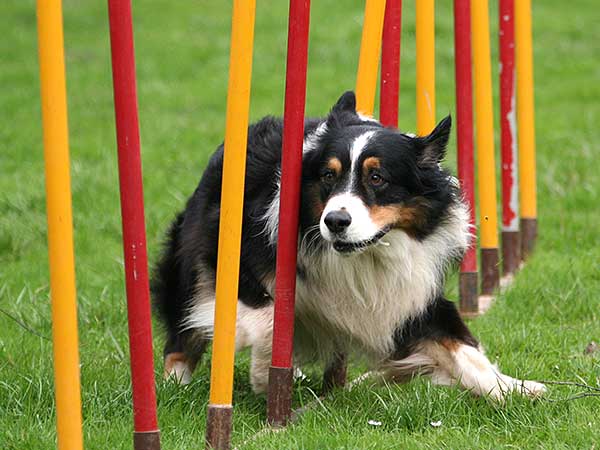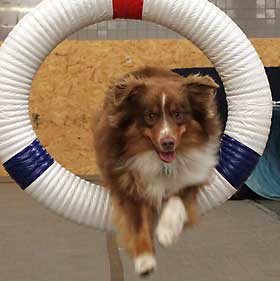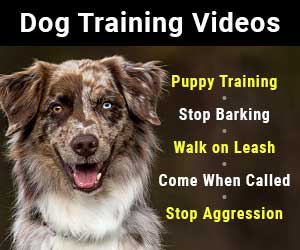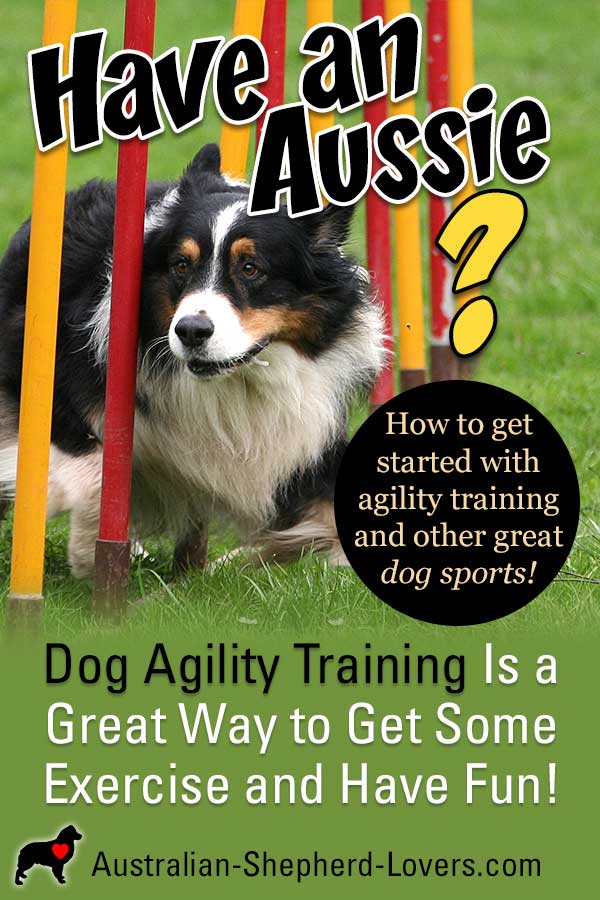
Dog Agility Training Is A Great Way To Get Some Exercise And Have A Lot Of Fun
Dog agility training is a fun, easy to learn sport that can have many benefits for both you and your dog. If you've ever seen an agility show on TV or attended one in person, you've no doubt seen dog and handler teams maneuvering through a series of obstacles, trying to clear them all as quickly and cleanly as possible. This is agility in a nutshell and it is the focus of this section of the site.
Here you'll find a comprehensive resource giving you all the information you could possibly need to bring you into the amazing world of agility dog training. You'll find sections covering agility equipment such as tunnels, weave poles and teeter-totters; the ins and outs of dog agility classes; the facts you need to know about training; where to find agility trials and lots of information on other dog sports like disc dog (Frisbee), dock diving, treibball, and lure coursing.
Before getting into the details, however, let's start with the basics of dog agility training. What exactly is it and why would anyone be interested in it? As described above, agility is a sport where a handler (that's you), guides a dog through a series of obstacles. In agility competition, the idea is to navigate the course as quickly as possible without taking any "faults." Faults can be given for everything from refusing an obstacle altogether (called a refusal or runout) to knocking down jump bars or taking the obstacles in the wrong order.

Sabine Glässl / stock.adobe.com
When it comes to dog agility training, Aussies love the competition—and the fun!
Any breed of dog can be trained to run an agility course, and any type of handler can participate as well. People of all ages and all physical conditions have worked in agility dog training with great success. That's one of the best parts of this particular sport. You don't have to be an Olympic quality athlete to be successful and your dog doesn't have to be a purebred. In fact, even the AKC will now allow mixed breeds to compete in agility.
Champion dogs in agility dog training are often Aussies. Of course, this comes as no surprise to Australian Shepherd owners. Australian Shepherds are naturals for this sport and dog agility competition is a perfect outlet for their incredible energy and a showcase for their athleticism.
Dog Agility Training For Mind And Body
That is particularly good news for interested Aussie owners because there are many benefits to be had from agility training with your dog. Not the least of which is getting a great physical workout for both you and your dog. As you run the course alongside your dog, giving hand and voice commands, you'll be getting a great cardio workout. And the training is just as good for your dog, helping to exercise both mind and body.
Mind? Yes, that's right, agility dog training can also help to work out your dog's brain, and that's more important than most people realize. That's because a dog's natural instinct is to work. While a routine walk is good for the body, it does nothing to challenge your dog, which can lead to boredom and bored dogs may become destructive or disobedient dogs. But challenging them to navigate a series of jumps, climbs, runs and crawls will allow them to flex both their physical and mental muscles.
Just as with any sport you will want to minimize any dog health problems or injuries that could arise. While agility dog training is a healthy and fun activity for you and your dog we want to make sure you stay safe out there. Be aware of potential issues and go at a pace you are both comfortable with.
Create A Better Bond With Agility Dog Training
At the same time, dog agility training helps to form a better bond between dog and owner. Because the two of you have to work so closely together, your dog will learn to depend on you and trust you, seeing you as a partner rather than just someone to provide food and water on a regular basis. In the long run, you'll find that agility training makes for a better dog/owner relationship and a stronger bond. What's not to love about that?
Safety is Essential For Dog Agility Training and Competition

Sandra Murphy
Australian Shepherds excel at dog agility training.
The only activity that Becky likes more than jumping hurdles and going through tunnels is catching her frisbee.
In order for agility training to stay fun for you and your Aussie make sure to play safe. You can begin agility training with your puppy but take it easy. If they are still a little unsteady hold off on the balancing equipment like dog walks and teeters until they are a bit older. You wouldn't want your puppy falling off the agility teeter and building a negative association with the equipment.
At the beginning the priority is familiarization with the agility equipment, learning to work as a team and building communication. If you have a puppy you might as well go slow because you won't be permitted to compete until they are older anyway.
This is for the safety and well being of your dog. Puppies are growing and their bodies are still developing. It is not recommended to engage in more physically demanding aspects of agility such as jumps and weaves until the growth plates of their bones have closed. This can take from 6 to 12 months depending on your dog and which bones. It takes longer for some growth plates to close than others.
Start Introduction to Dog Agility Training Slowly
Some dogs can take much longer than the average. Just because your dog appears to have stopped growing does not mean that the growth plates have closed completely. The growth plates will fill in as your dog matures fully.
Dog agility competitions have minimum age requirements for this reason. Some allow dogs to compete at 6 months, others insist on at least a year, but why take chances. I would recommend that you discuss this with your veterinarian and let her know exactly what your plans are with agility training and competition.
Some owners have their dogs x-rayed to ensure that it is safe for them to participate in agility training or competitions. This is also a good record of your dog's baseline bone structure as well as confirmation of growth plate closure. That way you have a means of making a comparison if you need to later in your dog's life. You will easily be able to see exactly how things have changed.
Just using common sense can eliminate most safety concerns. Can your dog see well enough to do agility training? Are their nails trimmed? (This will give them better traction.) Since your dog will be off-leash, do they come when called? Are they well enough socialized to get along with other dogs?
Where Can I Learn More About Dog Agility Training?
The dog agility sport is gaining in popularity and there are many clubs and training schools that can help you get started. If you just want to get involved with agility training for your enjoyment or if you want to go all out and someday compete for titles, this sport has something to offer. It's also a great way to meet new friends for both you and your Aussie.
Training schools and clubs will help you get started. Joining club will put you in touch with other enthusiasts who will be able to share stories and training tips. Soon you will be on your way to being a winning team - with lots of new friends.
The key word here is "fun". It has to be fun for you and your dog. So dogs should not be forced or scolded into participating or getting on, under, over or through a piece of equipment. Here's a dog agility training tip. Start early with your puppy or your dog and take it slow with your dog agility introduction. Use positive reinforcement and rewards for encouragement.
Dog Agility Equipment Doesn't Have To Cost A Fortune
The equipment for agility training and competitions can vary as courses are often quite different. You can order your own equipment and set it up to suit your needs (and the size of your yard). There is even software to help you design the layout of your obstacle course.
So check out the rest of this section and find out all the information you need to know about dog agility training. Before you know it, you and your best friend will be scaling new heights together!
Have Dog Training Questions?
Check out these introductory dog training videos...
I want my dog to stop being aggressive.
I want some help training my new puppy.
I want my dog to stop barking at everything.
Get Australian Shepherd Info, Website Updates, Special Offers, and Cartoons...
FREE GIFT
You'll also receive a free copy of the ebook
My Everyday Dog Training Tools
by professional dog trainer Daniel Abdelnoor, "Doggy Dan"













 Loading Image...
Loading Image...